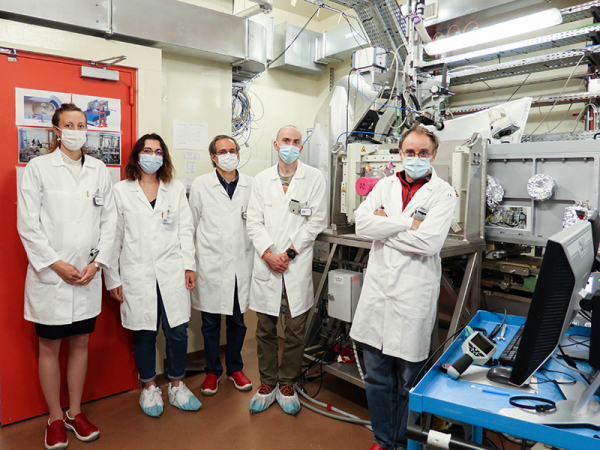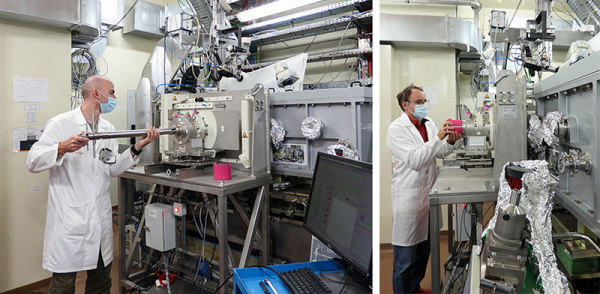Early in June 2021, researchers from the CEA in Cadarache and the MARS beamline studied the chemistry of a cross-section of spent nuclear fuel using X-ray absorption spectroscopy. Another technique, X-ray diffraction, was used on the same type of sample at the end of 2018.
The only synchrotron capable of receiving such massive, highly irradiating and contaminating samples, SOLEIL now also offers the possibility of combining techniques to analyse them. This is the culmination of a collaboration between CEA and SOLEIL initiated over 15 years ago, aimed at designing a beamline on which it is possible to study a section of nuclear fuel in its cladding.
Following the diffraction experiment carried out in November 2018, X-ray absorption spectroscopy (XAS) was used to analyse a massive sample of uranium oxide fuel, irradiated for five years in one of the Gravelines EDF nuclear power plants, on the MARS beamline at SOLEIL.
The analysed object was a UO2 sample of several milligrams* with a mean thickness of 50 µm. It represents a complete transverse section of a nuclear fuel rod as used in French pressurised water reactors: UO2 enriched to 4.48% with 235U, irradiated in a reactor and cooled for 25 years. Until now, in the world, the existing equipment was only suitable for measurements on just a few grains of powder or on small fragments.

Figure 1: The sample is prepared from a fuel rod (1 cm in diameter / 4 metres long, diagram of a section on the left). The researchers made a section of the fuel (middle) and various preparation manipulations to achieve a slice of a few milligrams, with a thickness of 50 μm and a width of 1 mm (2 photos on the right). © CEA
These results, by providing information on the chemical state of the fission products (elements resulting from the fission of uranium), will complete the X-ray diffraction data previously obtained, which, in turn, will provide access to the structural organisation of the fuel at the atomic scale and the local evolution of this organisation within a pellet. Such characterisations will contribute to defining the physical mechanisms involved within the fuel in order to take them into account in modelling, and thus better predict the evolution of its behaviour under irradiation.
Like the diffraction experiments in 2018, this characterisation by X-ray absorption of a massive fuel sample, highly irradiating and contaminating, makes this experiment a world premiere on a synchrotron.

The team involved in these absorption spectroscopy experiments. From left to right: Myrtille Hunault, scientist on the MARS beamline, Morgane Rochedy, PhD student at CEA Cadarache, Pier-Lorenzo Solari, MARS beamline manager, Vincent Klosek and Jean Noirot, researchers at CEA Cadarache. Sandrine Schlutig, researcher at CEA Cadarache, is not in the photo.
MARS, a beamline suitable for receiving irradiating materials
This success is the outcome of a collaboration between the teams of the CEA at Cadarache (Bouches-du-Rhône) and Saclay, (Essonne) and SOLEIL (Essonne). To meet its needs, the CEA wanted, as early as the 2000s, to be able to benefit from a "hot" beamline on a synchrotron capable of receiving irradiating and contaminating materials. Since the construction of the synchrotron, the CEA and SOLEIL teams have invested and worked together to build and adapt the equipment of the MARS (“Multi-Analyses on Radioactive Samples”) beamline.
The X-ray diffraction experiments required:
- Design of a mobile biological protection to transport and allow docking of the radioactive sample on the analysis station of the MARS beamline without the users being exposed to radiation;
- Preparation of a bulk fuel sample according to the required specifications;
- Authorisation from the Nuclear Safety Authority;
- Extraction of this sample from the hot laboratory (LECA-STAR) while respecting the radiological cleanliness criteria and transportation to the MARS beamline.
Since 2018, an additional step has been taken: a second shielding, this one adapted to X-ray absorption measurement instruments, has been developed. Installed on the absorption station of the MARS beamline in 2020, it provides radiation protection as effective as that suitable for X-ray diffraction equipment and therefore accommodates the same types of samples.
SOLEIL, with its MARS beamline, is currently the only synchrotron in the world to have these coupled X-ray diffraction/absorption analysis capacities for the nuclear materials scientific community, including the CEA teams, which will have privileged access to the MARS beamline due to the investments made in this equipment.

Left: In the experimental hutch of the MARS beamline, Vincent Klosek transfers the sample holder (containing the spent fuel section) from its transport cask to the sample analysis station by absorption spectroscopy.
Right: Jean Noirot replaces the lead plug on the transport casing after the sample holder has been transferred.
*Until now, the existing equipment in the world was only suitable for research on just a few grains of powder. Therefore, a sample of a few milligrams represents a massive sample for the scientists.
